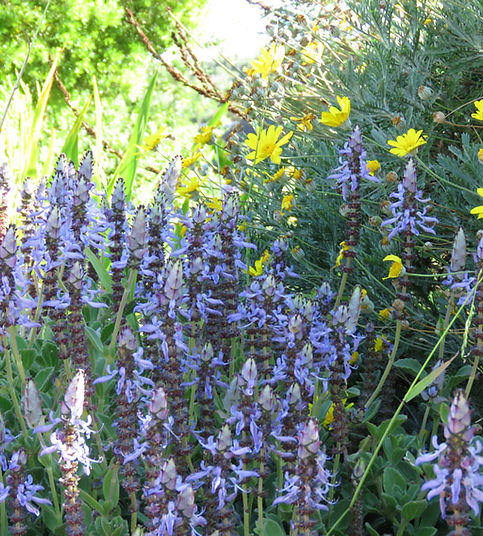Plectranthus neochilus
Water Needs
low; moderat

Succulent; Groundcover
Lobster Flower; Smelly Spur Flower; Rotstuinsalie
50 cm x 60 cm
Size
Light Conditions
sun; semi-shade
Frost
light; moderate
Flowers
blue-purple; spring, summer, autumn
Garden Situation
sun; semi-shade; afternoon sun; rockery gravel; sandy soils; paving; walls; green roof, green wall; container; slope bank; fast-growing easy-care; dry soil; windy exposed; narrow spaces; wildlife bees insects butterfly host
Habitat
urban streets, hot & dry, bushveld, coastal KZN, coastal Eastern Cape, grassland, rocky places
Region
thicket, subtropical East Coast, Highveld, bushveld savanna, karoo
Rain Season
summer; winter
Find informative indigenous gardening articles in our web magazine - www.theindigenousgardener.co.za
Description
Plectranthus neochilus has been overlooked by many urban gardeners until now, and the current drought has raised its profile as a generous and tough succulent groundcover for city landscapes. It thrives in arid, inhospitable traffic circles and city verges, on exposed rocky ground and baking-hot car parks, as well as more benevolent – though still dry - conditions in home gardens, beautifying the city landscape with hassle-free colour through spring and summer. Neither of the common English names, Lobster Flower (Newly formed buds resemble lobster claws before they open), or Smelly Spur Flower, excites my gardening heart nor does justice to this groundcover; I prefer the Afrikaans name of Rotstuinsalie, anglicised as Rock Garden Sage. Now that’s a plant I covet! Ernst van Jaarsveld uncovers 2 forms in his book, “The Southern African Plectranthus and the art of turning shade to glade”. ‘Pietersburg’ is a commonly grown form favoured for its small compact growth habit, originating in the Pietersburg area. It flowers from September to April. ‘Siteki’ forms a low-growing mat, growing up to 10 cm, with light blue to purple flowers and leaves covered in long, soft hairs. This species flowers in autumn and intermittently through spring and summer. Here, we showcase the ‘Pietersburg’ form. The Rotstuinsalie is an herbaceous perennial most effectively used as a groundcover in both sun and light shade areas, in both dry and moderately moist conditions. The succulent, grey-green leaves form an attractive dense cover year-round, and from September to April are covered in tall blue to purple spires, quite stunning in a massed display. Plants form neat, dense mounds with a height and spread of 50 cm x 60 cm, and seem to flower better in sunny situations and well-drained soils, less so when grown in too much shade. Plants can be used indoors and around patios as an air purifier. How to use this tough groundcover P. neochilus is at home in gravel gardens and rockeries and as an edging plant in a hot, dry bed. It is as equally at home amongst succulents, wildflowers and other perennials. Companions: Felicias, Scabiosa; Diascia, Ursinia, Euryops species, Curio, Kalanchoe and Cotyledon, Agapanthus. Care notes: This hardy groundcover needs little management, but, as stems can become a little woody, give a light prune after flowering to encourage fresh leaves and a more bushy growth.




